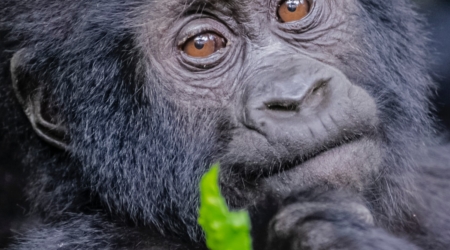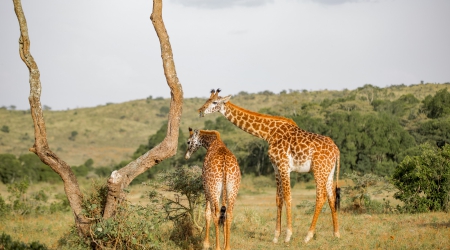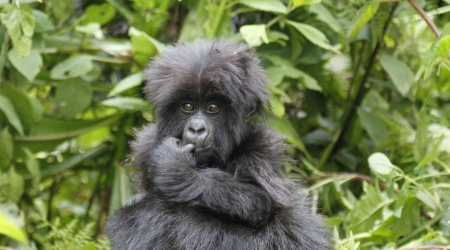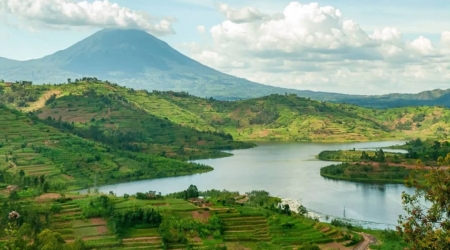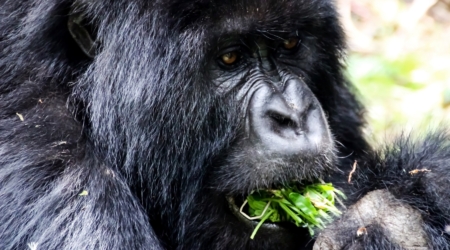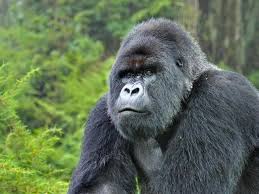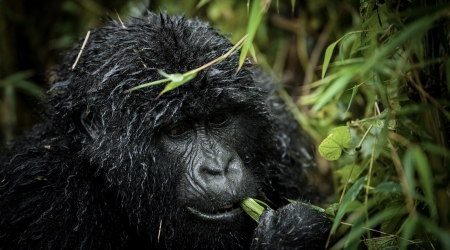Mountain gorillas, an iconic yet critically endangered species, inhabit the dense forests of the Virunga Mountains and Bwindi Impenetrable National Park. As we will see later in this article, their feeding habits contribute to forest regeneration and maintain ecological equilibrium. However, mountain gorillas face a growing existential threat: climate change. Rising temperatures, erratic weather patterns, habitat degradation, and increasing human-wildlife interactions are reshaping the environment in ways that jeopardise gorilla populations.
Mountain Gorilla Habitats
Mountain gorillas inhabit montane and bamboo forests at elevations ranging from 2,200 to 4,300 meters. These environments provide a stable food supply, dense vegetation for shelter, and a natural buffer against predators and human activity. The primary habitats—Bwindi Impenetrable National Park and the Virunga Massif— (Uganda, Rwanda, Congo) are characterised by cool temperatures, high humidity, and distinct wet and dry seasons that regulate the growth cycles of the vegetation gorillas depend on.
These forests function as self-sustaining ecosystems where gorillas play a role in seed dispersal and vegetation control. The availability of edible plant species, such as wild celery, bamboo shoots, and tree bark, directly influences gorilla movement patterns and social structures. Any disruption to this delicate balance, whether through climate change or human encroachment, affects the survival of mountain gorillas.
How Climate Change is Altering Gorilla Habitats
Climate change drives significant ecological shifts in the mountain forests where gorillas live. These alterations influence numerous factors, including the availability of food, the structure of forest ecosystems, and the frequency of extreme weather events.
a) Rising Temperatures and Disrupted Weather Patterns
Mountain gorillas have evolved to thrive in cool, high-altitude environments. However, global temperature increases are gradually altering the microclimate of their habitats. Warmer conditions at higher elevations due to climate change expand the range of particular plant and insect species while increasing the risk of heat stress for mountain gorillas. These primates rely on a delicate balance of vegetation that flourishes within specific temperature and moisture conditions. Even slight variations can disrupt the availability of essential food sources, forcing gorillas to travel longer distances to find sustenance.
Erratic rainfall patterns are another growing concern. Previously predictable wet and dry seasons are becoming increasingly irregular, with prolonged droughts leading to vegetation loss and unexpected heavy rains causing soil erosion and flooding. The delicate undergrowth mountain gorillas depend on for food and shelter is becoming less stable, impacting their ability to forage efficiently.
· Increased Rainfall and Its Effect on Vegetation
Shifts in precipitation are influencing forest composition, affecting the growth cycles of plants that mountain gorillas rely on for sustenance. In some areas, excessive rainfall is accelerating the growth of non-native plant species that compete with indigenous vegetation, reducing the availability of preferred food sources. This phenomenon also alters forest structure, with some trees and shrubs becoming more dominant while others struggle to survive under changing conditions.
Excess moisture also impacts the forest floor’s physical condition, making it more susceptible to landslides and degradation. This affects the gorillas’ movement through the habitat and increases the likelihood of habitat fragmentation, forcing groups into smaller, more isolated areas. The increased density of certain plants can also obstruct traditional pathways, leading to shifts in gorilla movement patterns and potentially heightening territorial disputes among groups.
b) Deforestation and Habitat Loss (Human Activity)
Climate change indirectly accelerates habitat loss by intensifying human pressures on protected areas. As unpredictable weather disrupts agricultural cycles, communities living near gorilla habitats increasingly encroach into forested regions for alternative farming land and resources. Deforestation, whether for fuelwood, farming, or settlement expansion, further fragments gorilla habitats, limiting their access to key feeding grounds and safe nesting sites.
Increased human presence also heightens the risk of direct conflict as gorillas are forced to live closer to human settlements. This increases the likelihood of human-wildlife interactions, often leading to accidental harm, habitat degradation, and increased vulnerability to disease transmission. As climate change continues to reshape ecological and socio-economic landscapes, conserving mountain gorilla habitats requires adaptive strategies for these emerging challenges.
Impact on Food Sources and Survival
Mountain gorillas rely on a specialized diet consisting primarily of leaves, stems, fruits, and bark, which they source from the diverse plant life in their high-altitude forest habitats. Climate change disrupts these food sources’ availability, nutritional composition, and seasonal patterns, directly affecting gorilla populations’ health, reproduction, and overall survival.
a) Changes in Plant Growth and Nutritional Value
Shifting climatic conditions destabilise the forest ecosystem’s delicate balance, ensuring a continuous supply of edible vegetation. Warmer temperatures and altered rainfall patterns modify plant growth cycles, leading to irregular blooming and fruiting seasons. Some plant species flourish at unexpected times, while others struggle to survive in the changing conditions. This disrupts the natural foraging patterns of mountain gorillas, forcing them to adapt to an increasingly unpredictable food landscape.
Beyond availability, climate change is also impacting the nutritional quality of vegetation. Increased carbon dioxide levels in the atmosphere can alter plant chemistry, reducing protein content while increasing the concentration of fibrous material. This means that even when food sources remain accessible, they may not provide the nutrients required for optimal health. Nutritional deficiencies can lead to weakened immune systems, reduced reproductive success, and increased vulnerability to disease.
· Food Scarcity and Its Effect on Gorilla Health
Periods of food scarcity are becoming more frequent as climate variability intensifies. When preferred food sources become limited, gorillas are forced to expend more energy searching for sustenance, often travelling longer distances and spending extended periods foraging. Increased physical exertion and reduced caloric intake can lead to weight loss, weakened physical condition, and greater susceptibility to illness.
b) Increased Competition for Resources
As climate change reshapes gorilla habitats, competition for resources is escalating among different gorilla groups and between gorillas and other wildlife species that rely on the same vegetation. Shifting food availability similarly affects baboons, duikers, and other herbivores, increasing interactions and potential competition for essential resources.
Additionally, food shortages can result in behavioral changes within gorilla groups. Increased competition for limited resources may lead to higher stress levels, conflicts among individuals, and disruptions in social cohesion. Dominant silverbacks, responsible for leading their groups, may struggle to maintain order if food scarcity causes heightened aggression or forces gorillas into less familiar areas for nourishment.
New Threats: Disease and Human-Wildlife Conflict
Climate change intensifies mountain gorillas’ challenges by increasing their exposure to infectious diseases and exacerbating conflicts with human populations. As ecosystems shift, disease outbreaks rise, and human-wildlife interactions become more common due to habitat pressures. These emerging threats further jeopardize the fragile stability of gorilla populations.
a) Climate Change and the Rise of Zoonotic Diseases
Mountain gorillas share approximately 98% of their DNA with humans, making them highly susceptible to many of the same infectious diseases. As climate change alters temperature and humidity levels, the risk of zoonotic disease transmission—where pathogens move between animals and humans—is becoming a significant concern.
Warmer temperatures and fluctuating rainfall patterns create favorable conditions for spreading respiratory infections, parasites, and vector-borne diseases. Malaria, once rare in high-altitude gorilla habitats, has been detected at increasing elevations as mosquitoes expand their range due to rising temperatures. Additionally, changes in vegetation and water availability influence the presence of bacteria and viruses that can affect gorillas and the humans who come into contact with them.
Stress from environmental instability also weakens gorillas’ immune responses, making them more vulnerable to infections. Increased movement in search of food, competition for resources, and habitat fragmentation contribute to higher stress levels, suppressing immune function and increasing susceptibility to disease outbreaks.
Higher Disease Vulnerability Due to Habitat Disruptions
Deforestation and human encroachment into gorilla habitats are facilitating the spread of pathogens. As human settlements expand closer to protected areas, the risk of disease transmission increases, mainly through indirect means such as contaminated water sources, agricultural runoff, and waste disposal. Gorillas that forage in areas near human activity are more likely to come into contact with domesticated animals and livestock, which can serve as carriers of infectious agents.
While critical for conservation funding, tourism also poses a risk of disease transmission. Although strict guidelines are in place to minimize direct contact between tourists and gorillas, climate-related health stressors may make gorillas more vulnerable to human-borne illnesses. Even minor respiratory infections, generally harmless to humans, can be fatal for gorilla populations. Conservation organizations continuously monitor gorilla health, but climate-related disruptions complicate disease prevention.
Increased Human Encroachment and Resource Competition
As climate change affects agricultural productivity, communities surrounding gorilla habitats face more economic pressure. Crop failures due to unpredictable weather patterns force local populations to seek alternative sources of income and sustenance, leading to increased reliance on forested areas for farming, firewood, and grazing land. This encroachment directly impacts gorilla habitats, reducing the availability of natural resources and increasing the likelihood of human-wildlife interactions.
Gorillas, in turn, are more frequently venturing outside protected areas in search of food, sometimes raiding farmland and consuming crops such as bananas, maize, and eucalyptus. These incidents create tension between conservation efforts and local livelihoods, often leading to retaliatory actions that threaten gorilla safety. Poaching, which has historically been driven by bushmeat hunting and illegal wildlife trade, is also influenced by economic hardship, and climate change is exacerbating the conditions that contribute to such activities.
What Can Be Done to Mitigate Climate Change’s Effects?
Efforts to mitigate climate change’s impact on mountain gorillas require combining global climate action, stronger conservation policies, and individual contributions.
- Global Climate Action: Reducing greenhouse gas emissions, investing in reforestation, and increasing international funding for conservation programs can help slow habitat degradation.
- Strengthening Conservation Policies: Expanding protected areas, improving anti-poaching measures, promoting sustainable land use, and enforcing tourism regulations help safeguard gorilla populations.
Individual Contributions: Supporting responsible tourism, advocating for environmental policies, reducing carbon footprints, and donating to conservation organizations to contribute to gorilla protection efforts.







